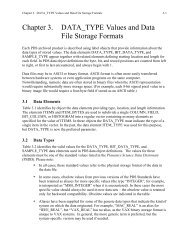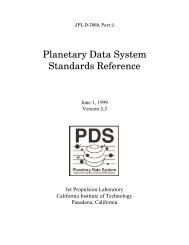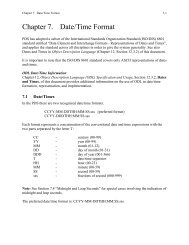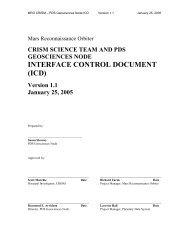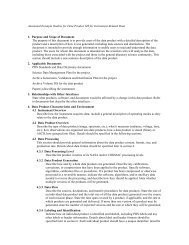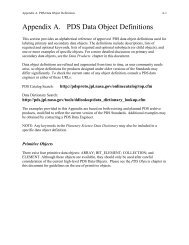Appendix C. Internal Representation of Data Types
Appendix C. Internal Representation of Data Types
Appendix C. Internal Representation of Data Types
You also want an ePaper? Increase the reach of your titles
YUMPU automatically turns print PDFs into web optimized ePapers that Google loves.
C-8 <strong>Appendix</strong> C. <strong>Internal</strong> <strong>Representation</strong> <strong>of</strong> <strong>Data</strong> <strong>Types</strong><br />
C.4 LSB_UNSIGNED_INTEGER<br />
Aliases: PC_UNSIGNED_INTEGER<br />
VAX_UNSIGNED_INTEGER<br />
This section describes unsigned integers stored in Least Significant Byte first (LSB) format. In<br />
this section the following definitions apply:<br />
b0 – b3<br />
i0 – i3<br />
Arrangement <strong>of</strong> bytes as they appear when reading a file (e.g., read byte<br />
b0 first, then b1, b2 and b3)<br />
Arrangement <strong>of</strong> bytes in the integer, from lowest order to highest order.<br />
The bits within each byte are interpreted from right to left (e.g., lowest<br />
value = bit 0, highest value = bit 7), in the following way:<br />
4-bytes:<br />
In i0, bits 0-7 represent 2**0 through 2**7<br />
In i1, bits 0-7 represent 2**8 through 2**15<br />
In i2, bits 0-7 represent 2**16 through 2**23<br />
In i3, bits 0-7 represent 2**24 through 2**31<br />
2-bytes:<br />
In i0, bits 0-7 represent 2**0 through 2**7<br />
In i1, bits 0-7 represent 2**8 through 2**15<br />
1-byte:<br />
In i0, bits 0-7 represent 2**0 through 2**7<br />
C.4.1<br />
LSB 4-byte Unsigned Integers



